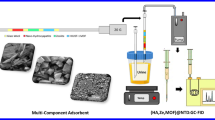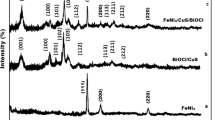Abstract
Self-produced peanut shell AC (activated carbon) and Al(OH)3 (aluminum hydroxide) were successfully synthesized by ultrasound with CTAB (cetyltrimethyl ammonium bromide), and both new nanocomposite AC@Al(OH)3@CTAB were evaluated as adsorbents for absorption of BPA (Bisphenol A) and utilized for the determination of BPA in urine by high-performance liquid chromatography coupled with fluorescence detector. Then the AC and AC@Al(OH)3@CTAB nanocomposites were examined by X-ray diffraction spectra, infrared spectrum, scanning electron microscope, transmission electron microscope, X-ray photoelectron spectroscopy techniques and differential pulse voltammetry analysis. The extraction elements such as adsorption pH, time, dose, desorption solvent, elution method were also discussed. Under the optimized extraction condition, the recovery of BPA in urine sample can achieve to 99.5% when using AC@Al(OH)3@CTAB as the SPE (solid-phase extraction) absorbents. For the methodological analysis, the linearity was detected in the range of 0.2–50 ng mL−1 (R2=0.999 3), and the limit of detection can be 0.05 ng mL−1. Within-day and between-day relative standard deviations were less than 3.7 and 5.2%, respectively. The synthesized new nanocomposite (AC@Al(OH)3@CTAB) showed excellent absorptive capacity, and the proposed SPE-HPLC-FLD methodology was proved to be efficient, sensitive and operable when using AC@Al(OH)3@CTAB as absorbents for BPA detection in complicated biological samples.








Similar content being viewed by others
References
Aimaretti G, Ambrosio MR, Somma CD, Fusco A, Cannavò S, Gasperi M, Scaroni C, Marinis LD, Benvenga S, Uberti ECD (2010) Traumatic brain injury and subarachnoid haemorrhage are conditions at high risk for hypopituitarism: screening study at 3 months after the brain injury. Clin Endocrinol 61(3):320–326
Arita Y, Park HJ, Cantillon A, Getahun D, Peltier MR (2019) Effect of bisphenol-A (BPA) on placental biomarkers for inflammation, neurodevelopment and oxidative stress. J Perinat Med 47(7):741–749
Cai W, Yu J, Jaroniec M (2010) Template-free synthesis of hierarchical spindle-like γ-Al2O3 materials and their adsorption affinity towards organic and inorganic pollutants in water. J Mater Chem 20(22):4587–4594
Caporossi L, Papaleo B (2017) Bisphenol A and metabolic diseases: challenges for occupational medicine. Int J Environ Res Public Health 14(9):959
Deng H, Su X, Wang H (2018) Simultaneous determination of aflatoxin B1, bisphenol A, and 4-nonylphenol in peanut oils by liquid-liquid extraction combined with solid-phase extraction and ultra-high performance liquid chromatography-tandem mass spectrometry. Food Anal Method 11(3):1303–1311
Edna R, Carina L, Susana V (2017) Occupational exposure to bisphenol A (BPA): a reality that still needs to be unveiled. Toxics 5(3):22
Geens T, Goeyens L, Kannan K, Neels H, Covaci A (2012a) Levels of bisphenol-A in thermal paper receipts from Belgium and estimation of human exposure. Sci Total Environ 435–436:30–33
Geens T, Neels H, Covaci A (2012b) Distribution of bisphenol-A, triclosan and n-nonylphenol in human adipose tissue, liver and brain. Chemosphere 87(7):796–802
Geng Y, Ding M, Chen H, Li HF, Lin JM (2012) Preparation of hydrophilic carbon-functionalized magnetic microspheres coated with chitosan and application in solid-phase extraction of bisphenol A in aqueous samples. Talanta 89(2):189–194
Goudarzi M, Ghanbari D, Salavati-Niasari M, Ahmadi A (2016) Synthesis and characterization of Al(OH)3, Al2O3 nanoparticles and polymeric nanocomposites. J Clust Sci 27(1):25–38
Hashemi B, Rezania S (2019) Carbon-based sorbents and their nanocomposites for the enrichment of heavy metal ions: a review. Microchim Acta 186(8):1–20
Huili W, Aina Z, Wenwei W, Minghua Z, Huanqiang L (2013) Separation and determination of triclosan and bisphenol A in water, beverage, and urine samples by dispersive liquid–liquid microextraction combined with capillary zone electrophoresis—UV detection. J Aoac Int 96(2):459–465
Iida T, Amano Y, Machida M, Imazeki F (2013) Effect of surface property of activated carbon on adsorption of nitrate ion. Chem Pharm Bull 61(3):1173–1177
Kang JH, Kondo F, Katayama Y (2006) Human exposure to bisphenol A. Toxicology 226(2–3):79–89
Krishnan AV, Stathis P, Permuth SF, Tokes L, Feldman D (1993) Bisphenol-A: an estrogenic substance is released from polycarbonate flasks during autoclaving. Endocrinology 132(6):2279–2286
Li X, Franke AA (2015) Improvement of bisphenol A quantitation from urine by LCMS. Anal Bioanal Chem 407(13):3869–3874
Lompe KM, Menard D, Barbeau B (2016) Performance of biological magnetic powdered activated carbon for drinking water purification. Water Res 96:42–51
Lv Y, Rui C, Dai Y, Pang Q, Li Y, Fan R, Lu S (2016) Exposure of children to BPA through dust and the association of urinary BPA and triclosan with oxidative stress in Guangzhou, China. Environ Ence Process Impacts 18(12):1492
Massoud K, Eilnaz Y, Ghasem S, Khajeh EA (2019) Highly sensitive determination of bisphenol A in bottled water samples by HPLC after Its extraction by a novel Th-MOF pipette-tip micro-SPE. J Chromatogr Sci 58(4):373–382
Newbold RR, Padilla-Banks E, Jefferson WN (2009) Environmental estrogens and obesity. Mol Cell Endocrinol 304(1–2):84
Olmo MD, Zafra A, Suárez B, Gonzalez-Casado A, Taoufiki J, Vílchez JL (2005) Use of solid-phase microextraction followed by on-column silylation for determining chlorinated bisphenol A in human plasma by gas chromatography-mass spectrometry. J Chromatogr B 817(2):167–172
Rao GP, Lu C, Su F (2007) Sorption of divalent metal ions from aqueous solution by carbon nanotubes: a review. Sep Purif Technol 58(1):224–231
Ribeiro E, Ladeira C, Viegas S (2017) Toxics EDCs mixtures: a stealthy hazard for human health? Toxics 5(1):5
Rivera-Utrilla J, Sanchez-Polo M, Gomez-Serrano V, Alvarez PM, Alvim-Ferraz MC, Dias JM (2011) Activated carbon modifications to enhance its water treatment applications. An overview. J Hazard 187(1–3):1–23
Rochester JR, Bolden AL (2015) Bisphenol S and F: a systematic review and comparison of the hormonal activity of bisphenol a substitutes. Environ Health Persp 123:643–650
Shi Y, Zhang L, Shao J, Shan X, Wu X (2021) Facile preparation of activated carbon from peanut shell for determination of bisphenol a in human urine by high-performance liquid chromatography. J Nanosci Nanotechnol 21(3):1439–1445
Shirvanimoghaddam K, Czech B, Wójcik G, Naebe M (2018) The light enhanced removal of Bisphenol A from wastewater using cotton waste derived carbon microtubes. J Colloid Interface Sci 539:425–432
Smith SC, Rodrigues DF (2015) Carbon-based nanomaterials for removal of chemical and biological contaminants from water: a review of mechanisms and applications. Carbon 91(2):122–143
Srivatsav P, Bhargav BS, Shanmugasundaram V, Arun J, Bhatnagar A (2020) Biochar as an eco-friendly and economical adsorbent for the removal of colorants (dyes) from aqueous environment: a review. Water 12(12):3561
Stojanoska MM, Milosevic N, Milic N, Abenavoli L (2017) The influence of phthalates and bisphenol A on the obesity development and glucose metabolism disorders. Endocrine 55(3):666–681
Su Y, Shao C, Huang X, Qi J, Ge R, Guan H, Lin Z (2018) Extraction and detection of bisphenol A in human serum and urine by aptamer-functionalized magnetic nanoparticles. Anal Bioanal Chem 410(10):1885–1891
Tremblay-Franco M, Cabaton NJ, Canlet C, Gautier R, Schaeberle CM, Jourdan F, Sonnenschein C, Vinson F, Soto AM, Zalko D (2015) Dynamic metabolic disruption in rats perinatally exposed to low doses of bisphenol-A. PLoS ONE 10(10):e0141698
Tuzimski T, Szubartowski S (2019) Method development for selected bisphenols analysis in sweetened condensed milk from a can and breast milk samples by HPLC–DAD and HPLC-QqQ-MS: comparison of sorbents (Z-SEP, Z-SEP Plus, PSA, C18, Chitin and EMR-Lipid) for clean-Up of QuEChERS extract. Molecules 24(11):2093
Valentino R, Esposito VD, Ariemma F, Cimmino I, Beguinot F, Formisano P (2015) Bisphenol A environmental exposure and the detrimental effects on human metabolic health: is it necessary to revise the risk assessment in vulnerable population? J Endocrinol Investig 39(3):259–263
Wen Y, Zhou BS, Xu Y, Jin SW, Feng YQ (2006) Analysis of estrogens in environmental waters using polymer monolith in-polyether ether ketone tube solid-phase microextraction combined with high-performance liquid chromatography. J Chromatogr A 1133(1–2):21–28
Xinghua L, Shuang L, Jialei B, Yuan P, Baoan N, Hongmei S, Weijun K, Huanying Z, Zhixian G (2019) Determination of bisphenol A by high-performance liquid chromatography based on graphene magnetic dispersion solid phase extraction. J Chromatogr Sci 58(3):280–286
Yan Z (2020) The bisphenol A market of China. Beijin, China Customs, August 06, 2020. https://www.chyxx.com/industry/202008/887273.html
Yin D, Chen Y, Zhang Y, Yang Z, Mao H, Xia S, Zhang W, Zhao W, Zhang S (2018a) 2D porous aromatic framework as a novel solid-phase extraction adsorbent for the determination of trace BPA in milk. Chromatographia 81(5):749–758
Yin Q, Wang R, Zhao Z (2018b) Application of Mg–Al-modified biochar for simultaneous removal of ammonium, nitrate, and phosphate from eutrophic water. J Clean Prod 176(2):230–240
Yin Q, Wang R, Zhao Z (2018c) Evaluation of nitrate and phosphate adsorption on Al-modified biochar: influence of Al content. Sci Total Environ 631–632:(91):895–903
Yousefi M, Noori E, Ghanbari D, Salavati-Niasari M, Gholami T (2014) A facile room temperature synthesis of zinc oxide nanostructure and its influence on the flame retardancy of poly vinyl alcohol. J Clust Sci 25(2):397–408
Zhang M, Gao B (2013) Removal of arsenic, methylene blue, and phosphate by biochar/ AlOOH nanocomposite. Chem Eng J 226(3):286–292
Zhao RS, Wang X, Yuan JP, Zhang LL (2009) Solid-phase extraction of bisphenol A, nonylphenol and 4-octylphenol from environmental water samples using microporous bamboo charcoal, and their determination by HPLC. Microchim Acta 165(3–4):443–447
Zhou Q, Wang W, Xiao J, Wang J, Liu G, Shi Q (2006) Comparison of the enrichment efficiency of multiwalled carbon nanotubes, c18 silica, and activated carbon as the adsorbents for the solid phase extraction of atrazine and simazine in water samples. Microchim Acta 152(3–4):215–224
Acknowledgements
This work was financially supported by National Natural Science Foundation of China (No. 21607135), Zhejiang Medical and Health Science and Technology Project (No. 2019KY543, NO. 2018KY640) and the Hangzhou Foundation for Development of Science and Technology (No. 20180533B95).
Author information
Authors and Affiliations
Corresponding author
Ethics declarations
Conflict of interest
There are no conflicts of interest to declare.
Ethical approval
Ethical approval was given by the medical ethics committee of Hangzhou Occupational Disease Prevention and Control Hospital.
Additional information
Publisher's Note
Springer Nature remains neutral with regard to jurisdictional claims in published maps and institutional affiliations.
Siwei Tan and Xiaoyin Ruan have contributed equally to this work
Rights and permissions
About this article
Cite this article
Tan, S., Ruan, X., Shao, J. et al. Facile preparation of aluminum nanocomposites and the utilization in analyzing BPA in urine samples. Chem. Pap. 76, 2029–2039 (2022). https://doi.org/10.1007/s11696-021-01983-3
Received:
Accepted:
Published:
Issue Date:
DOI: https://doi.org/10.1007/s11696-021-01983-3




